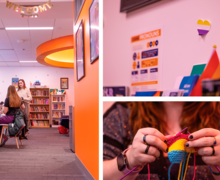Representative of firm in the running to design NVRC discusses past projects
Rachel Kline | Contributing Photographer
Craig Dykers, a representative of one of the architecture firms that may design the National Veteran Resource Complex at Syracuse University, discusses the firm’s past projects.
A representative from the architecture firm Snohetta presented images on Tuesday of buildings the firm has previously designed at the first of a three-part lecture series from the firms that have been chosen as finalists to design the National Veterans Resource Complex at Syracuse University.
Craig Dykers spoke in front of a packed Slocum Hall Auditorium, flipping through projected images of buildings across the world that Snohetta has designed, including theaters and libraries. Snohetta, Adjaye Associates and SHoP are the three finalists to design the NVRC. All three firms are also finalists to design the Obama Presidential Library in Chicago, dedicated to United States President Barack Obama.
Design proposals for the NVRC were not discussed Tuesday and will not be discussed during the lecture series.
The NVRC, which was proposed by SU in October 2015, will serve as a hub for research and programming related to veteran and military affairs in central New York. The complex will also be the center of veteran life on the SU campus.
Dykers, who also serves as a visiting critic in SU’s New York City architecture studio, showed images of the inside and outside of buildings including the Library of Alexandria in Egypt; the Norwegian National Opera and Ballet in Oslo; and the Isabel Bader Centre for the Performing Arts at Queen’s University in Kingston, Ontario, among others.
Dykers also showed photos of the Times Square reconstruction project that Snohetta is currently leading.
The Library of Alexandria is an 11-story building that took roughly 13 years to construct, from 1989-2001, Dykers said. The library is of a circular form and sits on a steep tilt.
The Norwegian National Opera and Ballet is also built on a slant, with an accessible roof on top.
Both the library and the Isabel Bader Centre for the Performing Arts house a number of tenants. The library houses museums, a planetarium and a school for information science and conservation facilities, while the Isabel Bader Centre serves as a home for a performance hall, classrooms and performance spaces for several departments at Queen’s University.
That’s similar to the NVRC in that the complex is expected to serve as a home to eight tenants, including SU’s Institute for Veterans and Military Families and the Office of Veterans and Military Affairs.
Many of the buildings that Dykers showed Tuesday have prominent, public lobbies, including the Isabel Bader Centre and the Norwegian National Opera and Ballet.
Dykers also discussed Snohetta’s ongoing reconstruction of the public space in Times Square. The firm is focusing on improving “physical and operational conditions of the streets, sidewalks and sub-surface infrastructure” with the goal of increasing the functionality and safety of Times Square, according to Snohetta’s website.
The area has already become more pedestrian-friendly, as there has been a 40 percent decrease in pedestrian injuries since the start of the reconstruction, Dykers said.
The pedestrian-friendly aspect could be of interest to SU. At a Campus Framework update session earlier this month, Michael Speaks, the dean of SU’s School of Architecture, discussed potential plans to make both University Place and Waverly Avenue — where the NVRC is expected to be built — more pedestrian-friendly with the creation of promenades.
Dykers closed his lecture with a short Q&A session before a reception took place in the first-floor atrium of Slocum Hall.
The next lecture in the series is set for March 31, when William Sharples of SHoP will speak in Slocum Hall Auditorium at 6 p.m.
Published on March 23, 2016 at 12:01 am
Contact Michael: mdburk01@syr.edu





